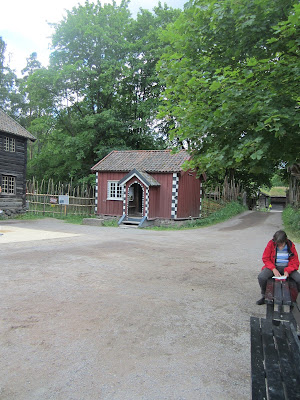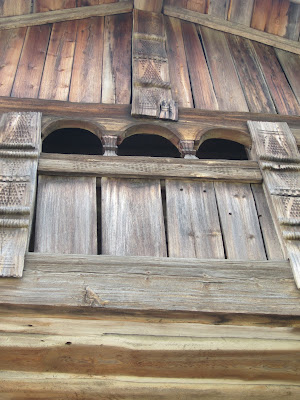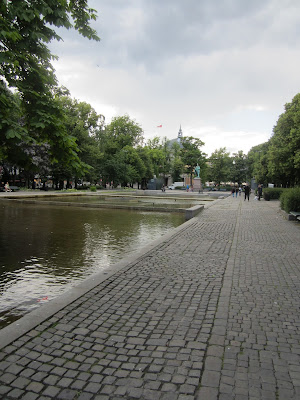Gol Stave Church at the Folk Museum
The day before we were to leave it was agreed that Alf would pick us up the next morning and take us from Eldbjørg’s home in Evje og Hornnes to the airport at Krisitiansand. From there we left on a small plane very early in the morning and had one day and night in Oslo before moving on to Vienna, Austria for the rest of our trip. The result of such a short stay in Oslo meant careful consideration concerning what we could see and do in such a limited time frame. Bob really wanted to see the Viking Ship Museum (see the Thursday postcard #154, from 7 August 2014) and I wanted to visit the open-air Folk Museum that I had not been able to see the last time I visited Norway all those years ago. Both were located close together a short boat trip away from the city center and we thought it would offer the most sightseeing opportunity for one day. The harbor was some distance from our hotel; however, we are used to walking and the walk would also give us more opportunity to see other parts of the city.
It was too early to check into our room but the hotel staff kindly offered to let us leave our bags there while we went off for a day of sightseeing. We noticed a lot of activity near the harbor and later discovered that a huge Rock concert was scheduled for that evening. The entire area was crowded with people and loud music by the time we returned at the end of the day!
Street scenes from the hotel to the harbor
Stortinget where Norway's National Assembly meets
The boat we took to the island. It was roomy inside and had seats for lots of tourists with plenty of big windows to look out.
Akershus, Norway's best preserved castle from the middle ages
It was a beautiful sunny warm day and the boat ride to Bygdøy where the museums are located was pleasant. The Norsk Folkemuseum was founded in 1894 by Hans Aall and is a showcase of how our ancestors lived and worked many years ago. There are 155 historic buildings dating from the middle ages onward. It is about a 1/2 mile walk from the boat landing to the museum.
The grounds are divided into sections with examples of the houses and activities for each region of Norway represented. Docents in costume are available at each site ready to explain, take photos, visit, and even give short lectures for tours. In addition to the farmsteads and countryside examples there are also city streets and apartment buildings that have been reconstructed to provide an idea of what life was like. We did not take a formal tour but bought a booklet and did our own private walking tour of the grounds.
Gol Stave Church was taken apart and reassembled on the museum grounds
Probably the most impressive building we came upon after entering the museum grounds was the reconstructed Gol Stave church from Hallingdal. The interior of the church was dark; however, we did get a few photos. Two girl docents wearing traditional folk costumes were there to answer questions and posed for pictures when asked. Many of the young people acting as docents were students at the nearby university.
The pictures below show the streets, farmsteads and a few interior photos from various buildings.
 |
Not wallpaper but Rosemaling on the wooden walls. Very beautiful.
Below a very old primitive Lapp or Sami dwelling house made of sod and sticks.
The Norsk Folkemuseum is a fantastic place to visit. It could easily take all day or more than one day to see everything. Our choice to walk most everywhere was the correct one for us. We saw so much more of the city in the short time we had than we could have done otherwise. We also took opportunities to talk with local people, ask directions and questions about what was going on when we couldn't figure it out.
This beautiful sailing ship (also carrying tourists) coming into the harbor as we returned from our day at the museums.
On the walk back to the hotel we passed the Rock Concert venue, a brass band playing by a park, the Royal Palace, and other interesting places.
Large sign advertising the Rock Concert
Brass band
Two views of the park and pond
The Royal Palace






















































